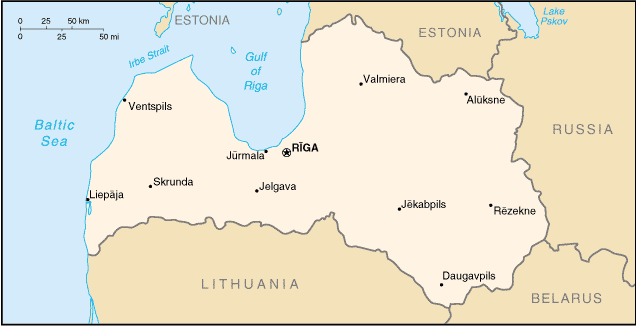This is an old revision of this page, as edited by Jeronimo (talk | contribs) at 15:44, 8 January 2003. The present address (URL) is a permanent link to this revision, which may differ significantly from the current revision.
Revision as of 15:44, 8 January 2003 by Jeronimo (talk | contribs)(diff) ← Previous revision | Latest revision (diff) | Newer revision → (diff)]
The Republic of Latvia is a country in eastern Europe. Bordering the Baltic Sea, Latvia is known as one of the Baltic Countries, together with Estonia and Lithuania, which border the nation in the north and south, respectively. In the east, it shares borders with Russia and Belarus.
| |||||
| National motto: Xxxxx | |||||
| Official language | Latvian | ||||
| Capital | Riga | ||||
| President | Vaira Vike-Freiberga | ||||
| Prime minister | Andris Berzins | ||||
| Area - Total - % water | Ranked 122nd 64,589 km² 1.5% / Negligible | ||||
| Population
- Density | Ranked 137th
37/km² | ||||
| August 21, 1991 | |||||
| Currency | Lat | ||||
| Time zone | UTC+2 | ||||
| National anthem | Dievs, Sveti Latviju | ||||
| Internet TLD | .LV | ||||
| Calling Code | XX | ||||
History
Main article: History of Latvia
Known as Livonia, the area that now constitues Latvia was under German influence in the first millenium BC and the centuries after that. However, in the 18th and 19th century, Russia gained control over Latvia.
With Russia devastated by revolution and World War I, Latvia declared its independence in November 1918. This period of independence lasted only briefly, as the Soviet Union annexed the country in August of 1939.
Except for a brief period of German occupation during World War II, Latvia remained Soviet territory until the 1980s. Reforms in Soviet communism stimulated the Latvian independence movement, and Latvia regained independence in 1991.
Politics
Main article: Politics of Latvia
The 100-seat Latvian parliament, Saeima, is elected every four years. The presidential elections are held separately, also every four years. The president appoints a prime minister, who together with his cabinet, forms the executive branch of the government.
Counties
Main article: Counties of Latvia
Latvia is divided into 26 counties called rajons. 7 cities have a separate status.
- Aizkraukles Rajons
- Aluksnes Rajons
- Balvu Rajons
- Bauskas Rajons
- Cesu Rajons
- Daugavpils
- Daugavpils Rajons
- Dobeles Rajons
- Gulbenes Rajons
- Jekabpils Rajons
- Jelgava
- Jelgavas Rajons
- Jurmala
- Kraslavas Rajons
- Kuldigas Rajons
- Liepaja
- Liepajas Rajons
- Limbazu Rajons
- Ludzas Rajons
- Madonas Rajons
- Ogres Rajons
- Preilu Rajons
- Rezekne
- Rezeknes Rajons
- Riga
- Rigas Rajons
- Saldus Rajons
- Talsu Rajons
- Tukuma Rajons
- Valkas Rajons
- Valmieras Rajons
- Ventspils
- Ventspils Rajons
Geography
Main article: Geography of Latvia
Large parts of Latvia are covered by forests, and the country has countless small rivers and lakes. Most of the country are plains, with some hills, the highest being about 300 m.
An inlet of the Baltic Sea, the Gulf of Riga is situated in the northwest of the country. The capital city Riga is located on the shores of this inlet, where the Daugava river flows into it. Other major cities include Daugavpils and Liepaja.

Economy
Main article: Economy of Latvia
Latvia's transitional economy recovered from the 1998 Russian financial crisis, largely due to the Skele government's budget stringency and a gradual reorientation of exports toward EU countries, lessening Latvia's trade dependency on Russia. The majority of companies, banks, and real estate have been privatized. Latvia officially joined the World Trade Organization in February 1999 - the first Baltic state to join - and was invited at the Helsinki EU Summit in December 1999 to begin accession talks in early 2000. Preparing for EU membership over the next few years remains a top foreign policy goal. The high current account deficit remains a major concern.
Demographics
Main article: Demographics of Latvia
Less than 60% of the population of Latvia are ethnic Latvians. About 30% is Russian, causing Russia to interfere often with their wellbeing. Sizeable minorities from the other neighbouring countries and Poland also live in Latvia.
Latvian is the country's only official language, but Russian is widely spoken. The population is almost entirely Christian, but divided between the Lutheran, Catholic and Russian Orthodox Churches.